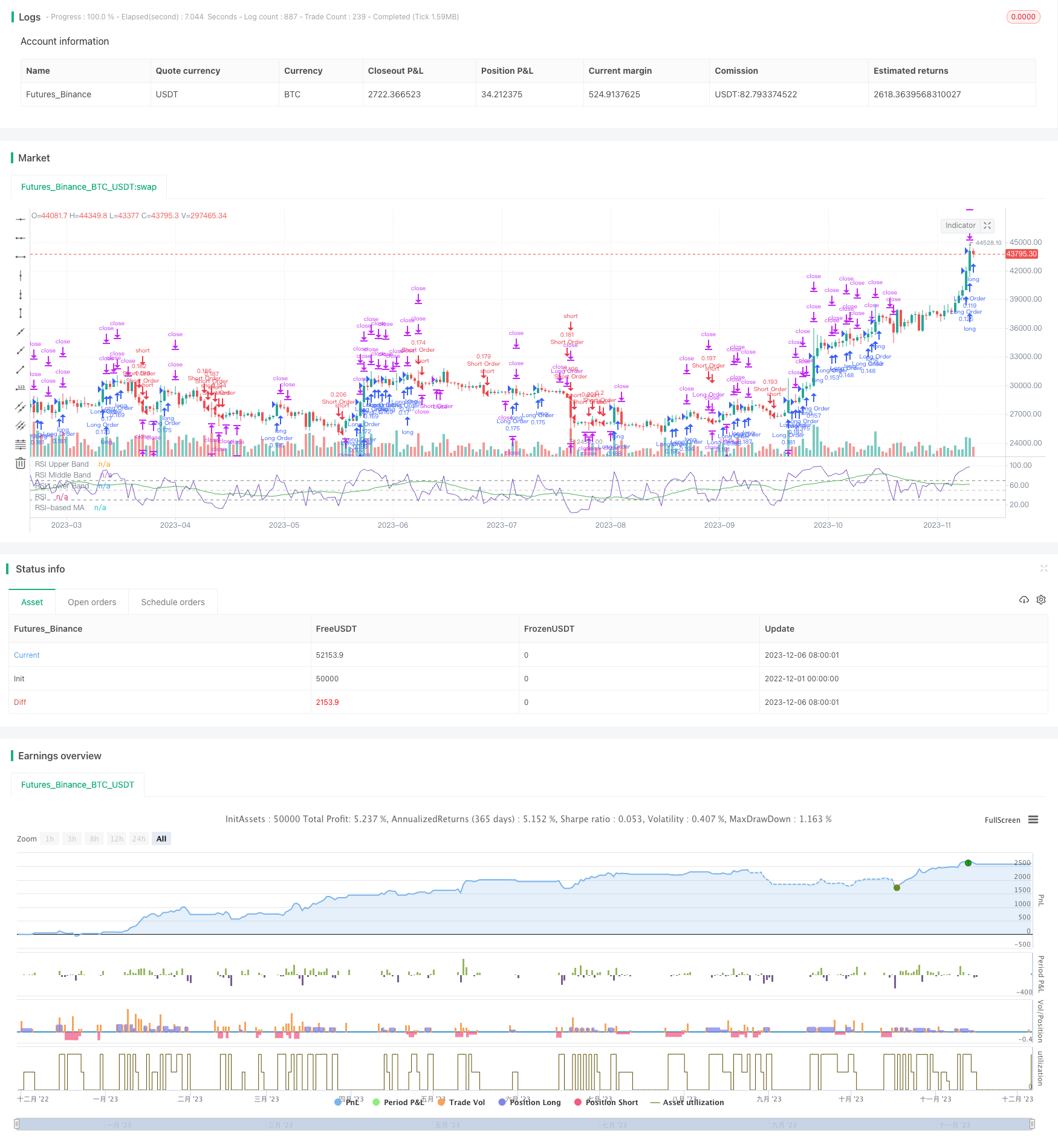RSI トレンドフォロー トレーリングストップ戦略

概要
この戦略は,RSI指標を用いてトレンドを識別し,移動平均線と組み合わせてトレンドを確認し,ストップを設定する自動取引戦略である.RSIが68より大きく,現在の移動平均線を突破する前に移動平均線を多く行い,RSIが28より小さく,現在の移動平均線を突破する前に移動平均線を空にする.同時にストップを設定する.
戦略原則
この戦略は,主にRSI指標を用いて,超買超売現象のトレンド識別を行う. RSIが70以上になると超買区,30未満になると超売区となる. 移動平均を組み合わせた黄金の交差点と死の交差点によるトレンド確認を行う. 具体的取引信号は,
多頭シグナル:RSIが68以上で,現在の移動平均線を移動平均線に突破する前,多行する. 空頭シグナル:RSIが28未満で,現在の移動平均を下に突破する前に移動平均を空にする.
止損停止設定は,各点位に異なる止損停止比率を設定し,より緩やかからより厳格に設定します.具体的には:
多頭ストップ:高点1.4%ストップ半ポジション,高点0.8%ストップ全平ポジション 多頭ストップ:入場価格の2%をセットストップ.
空頭ストップ:低点0.4%ストップ半ポジション,低点0.8%ストップ全平仓.
空頭ストップ:入場価格の2%をセットストップ.
また,トレンドが逆転する時,例えば多時RSIが30を破ると市場価格が完全に平仓する.空白時RSIが60を破ると市場価格が完全に平仓する.
戦略的優位性
- RSI指標で超買いと超売りを判断し,高殺低を追うのを避ける.
- 移動平均はトレンドフィルタリングを行い,非主流方向の操作を減らす.
- 利潤を最大化するために,進捗制限を設定します.
- トレンドに適切なスペースを与えるため,高いストップポイントを設定します.
- トレンド転換指数の逆清算戦略と組み合わせた,突発的な事件への迅速な対応.
戦略リスク
- RSIパラメータの設定の問題により,識別がうまくいきませんでした.
- 移動平均のパラメータ設定の問題で,フィルターの効果が悪かった.
- ストップポイントが緩やかすぎると,損失が拡大するリスクがある.
- ストップポイントが狭すぎると,収益を最大化することができません.
- 逆転清算策の誤った判断により,不必要な損失が発生した.
上記のリスクに対して,パラメータを何度かテストして最適化しなければならない.止損の設定は適切で,一定範囲の緩和を行い,市場の変動度に応じてパラメータを調整しなければならない.清算戦略は慎重に,指標の誤判で損失を招くのを避けるべきである.
最適化の方向
更に,以下の点で最適化できます.
- さらに多くの波指標を追加し,信号の正確性を向上させる.例えば,取引量フィルターを追加する.
- ストップ・ストラトジーを調整し,最高値と最低値を追跡し,移動ストップを実現する.
- ストップを部分的に調整してストップを追跡し,利潤を最大化します.
- データソースの切り替え,異なる品種の異なる周期の使用などのパラメータの組み合わせを追加します.
- 期貨空置保有コストの考慮を増加させ,ストップ・ストップを動的に調整する.
要約する
この戦略は,全体として,より成熟した信頼性の高いトレンド追跡戦略である. RSIを判断し,オーバーバイのオーバーセルの現象を判断して取引の方向を決定する. 移動平均を使用し,波の確認を行う. 同時に,適切なストープと進行停止を設定する. トレンドの中でよりよい収益を得ることができる.
// © CRabbit
//@version=5
// Starting with $100 and using 10% of the account per trade
strategy("RSI Template", shorttitle="RSI", overlay=false, initial_capital=100, default_qty_value=10, default_qty_type=strategy.percent_of_equity)
// RSI Indicator
ma(source, length, type) =>
switch type
"SMA" => ta.sma(source, length)
"Bollinger Bands" => ta.sma(source, length)
"EMA" => ta.ema(source, length)
"SMMA (RMA)" => ta.rma(source, length)
"WMA" => ta.wma(source, length)
"VWMA" => ta.vwma(source, length)
rsiLengthInput = input.int(4, minval=1, title="RSI Length", group="RSI Settings")
rsiSourceInput = input.source(close, "Source", group="RSI Settings")
maTypeInput = input.string("SMA", title="MA Type", options=["SMA", "Bollinger Bands", "EMA", "SMMA (RMA)", "WMA", "VWMA"], group="MA Settings")
maLengthInput = input.int(23, title="MA Length", group="MA Settings")
bbMultInput = input.float(2.0, minval=0.001, maxval=50, title="BB StdDev", group="MA Settings")
up = ta.rma(math.max(ta.change(rsiSourceInput), 0), rsiLengthInput)
down = ta.rma(-math.min(ta.change(rsiSourceInput), 0), rsiLengthInput)
rsi = down == 0 ? 100 : up == 0 ? 0 : 100 - (100 / (1 + up / down))
rsiMA = ma(rsi, maLengthInput, maTypeInput)
isBB = maTypeInput == "Bollinger Bands"
plot(rsi, "RSI", color=#7E57C2)
plot(rsiMA, "RSI-based MA", color=color.green)
rsiUpperBand = hline(70, "RSI Upper Band", color=#787B86)
hline(50, "RSI Middle Band", color=color.new(#787B86, 50))
rsiLowerBand = hline(30, "RSI Lower Band", color=#787B86)
fill(rsiUpperBand, rsiLowerBand, color=color.rgb(126, 87, 194, 90), title="RSI Background Fill")
// Configure backtest start date with inputs
startDate = input.int(title="Start Date", defval=1, minval=1, maxval=31)
startMonth = input.int(title="Start Month", defval=6, minval=1, maxval=12)
startYear = input.int(title="Start Year", defval=2022, minval=1800, maxval=2100)
// See if this bar's time happened on/after start date
afterStartDate = (time >= timestamp(syminfo.timezone,
startYear, startMonth, startDate, 0, 0))
// Long and Short buy strategy
// Submit a market open/ close Long order, but only on/after start date
if (afterStartDate)
if rsi > 68 and (rsiMA > rsiMA[1])
strategy.entry("Long Order", strategy.long, comment="ENTER-LONG")
if rsi < 30
strategy.close("Long Order", alert_message="L-CL")
strategy.exit("L-TP1", from_entry="Long Order", limit=high * 1.004, qty_percent=50, alert_message="L-TP1" + str.tostring(high * 1.004))
strategy.exit("L-TP2", from_entry="Long Order", limit=high * 1.008, qty_percent=100, alert_message="L-TP2" + str.tostring(high * 1.008))
strategy.exit("Exit Long", from_entry="Long Order", stop=low * 0.98, alert_message="L-SL" + str.tostring(low * 0.98))
// Submit a market Open/ Close Short order, but only on/after start date
if (afterStartDate)
if rsi < 28 and (rsiMA < rsiMA[1])
strategy.entry("Short Order", strategy.short, comment="ENTER-SHORT")
if rsi > 60
strategy.close("Short Order", alert_message="S-CL")
strategy.exit("S-TP1", from_entry="Short Order", limit=low * 0.996, qty_percent=50, alert_message="S-TP1" + str.tostring(low * 0.996))
strategy.exit("S-TP2", from_entry="Short Order", limit=low * 0.992, qty_percent=100, alert_message="S-TP2" + str.tostring(low * 0.992))
strategy.exit("Exit Short", from_entry="Short Order", stop=high * 1.02, alert_message="S-SL" + str.tostring(high * 1.02))
// MONTHLY TABLE //
prec = input(2, title = "Return Precision")
new_month = month(time) != month(time[1])
new_year = year(time) != year(time[1])
eq = strategy.equity
bar_pnl = eq / eq[1] - 1
cur_month_pnl = 0.0
cur_year_pnl = 0.0
// Current Monthly P&L
cur_month_pnl := new_month ? 0.0 :
(1 + cur_month_pnl[1]) * (1 + bar_pnl) - 1
// Current Yearly P&L
cur_year_pnl := new_year ? 0.0 :
(1 + cur_year_pnl[1]) * (1 + bar_pnl) - 1
// Arrays to store Yearly and Monthly P&Ls
var month_pnl = array.new_float(0)
var month_time = array.new_int(0)
var year_pnl = array.new_float(0)
var year_time = array.new_int(0)
if (not na(cur_month_pnl[1]) and (new_month or barstate.islast))
array.push(month_pnl , cur_month_pnl[1])
array.push(month_time, time[1])
if (not na(cur_year_pnl[1]) and (new_year or barstate.islast))
array.push(year_pnl , cur_year_pnl[1])
array.push(year_time, time[1])
// Monthly P&L Table
var monthly_table = table(na)
if (barstate.islast)
monthly_table := table.new(position.bottom_right, columns = 14, rows = array.size(year_pnl) + 1, border_width = 1)
table.cell(monthly_table, 0, 0, "", bgcolor = #cccccc)
table.cell(monthly_table, 1, 0, "Jan", bgcolor = #cccccc)
table.cell(monthly_table, 2, 0, "Feb", bgcolor = #cccccc)
table.cell(monthly_table, 3, 0, "Mar", bgcolor = #cccccc)
table.cell(monthly_table, 4, 0, "Apr", bgcolor = #cccccc)
table.cell(monthly_table, 5, 0, "May", bgcolor = #cccccc)
table.cell(monthly_table, 6, 0, "Jun", bgcolor = #cccccc)
table.cell(monthly_table, 7, 0, "Jul", bgcolor = #cccccc)
table.cell(monthly_table, 8, 0, "Aug", bgcolor = #cccccc)
table.cell(monthly_table, 9, 0, "Sep", bgcolor = #cccccc)
table.cell(monthly_table, 10, 0, "Oct", bgcolor = #cccccc)
table.cell(monthly_table, 11, 0, "Nov", bgcolor = #cccccc)
table.cell(monthly_table, 12, 0, "Dec", bgcolor = #cccccc)
table.cell(monthly_table, 13, 0, "Year", bgcolor = #999999)
for yi = 0 to array.size(year_pnl) - 1
table.cell(monthly_table, 0, yi + 1, str.tostring(year(array.get(year_time, yi))), bgcolor = #cccccc)
y_color = array.get(year_pnl, yi) > 0 ? color.new(color.green, transp = 50) : color.new(color.red, transp = 50)
table.cell(monthly_table, 13, yi + 1, str.tostring(math.round(array.get(year_pnl, yi) * 100, prec)), bgcolor = y_color)
for mi = 0 to array.size(month_time) - 1
m_row = year(array.get(month_time, mi)) - year(array.get(year_time, 0)) + 1
m_col = month(array.get(month_time, mi))
m_color = array.get(month_pnl, mi) > 0 ? color.new(color.green, transp = 70) : color.new(color.red, transp = 70)
table.cell(monthly_table, m_col, m_row, str.tostring(math.round(array.get(month_pnl, mi) * 100, prec)), bgcolor = m_color)